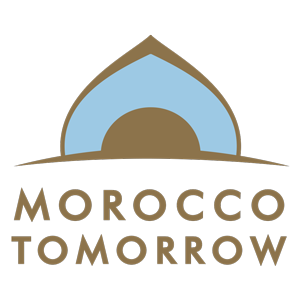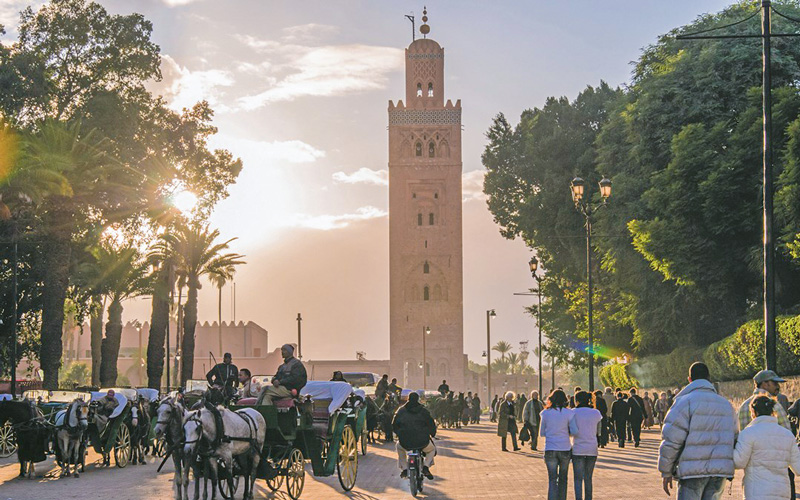 The 1,200-year-old Medina in Fez, Morocco, may be car-free — but taking in its exotic sights while hopscotching around donkey droppings is the pedestrian equivalent of distracted driving. I’m overwhelmed: drawn toward a pyramid of bright lemons, repelled by a heap of steamed snails; enamored of silver teapots, then shocked to come face to face with a severed camel head hooked on a butcher’s booth.
The 1,200-year-old Medina in Fez, Morocco, may be car-free — but taking in its exotic sights while hopscotching around donkey droppings is the pedestrian equivalent of distracted driving. I’m overwhelmed: drawn toward a pyramid of bright lemons, repelled by a heap of steamed snails; enamored of silver teapots, then shocked to come face to face with a severed camel head hooked on a butcher’s booth.
I’m on my way to meet David Amster. Although the American expat directs Fez’s Arabic Language School, his passion for “old things” puts him squarely amid recent efforts to restore the Medina.
Fès-el-Bali (“Old Fès”) was declared a UNESCO world heritage site in 1981. It’s easy to see why: Among its 9,500 alleyways are stunning mosques, the world’s oldest university and lively souks, or markets. Fès-el-Bali is considered the best-preserved medieval city in the Arab world, the cultural equivalent of an old-growth forest.
But the centuries are taking a toll. As I tread the uneven cobblestone toward Amster’s house, I note the aging physical structure of the Medina. Shop doors are askew. Hand-chiseled tiles called zellij are faded and chipped. Old wooden beams collect the dust of ages. But while in some places the wear and tear adds to the aesthetic, in other places it’s precarious: Ceilings bow, and walls fissure. Some structures look downright dangerous and, in fact, are. Houses in the Medina regularly collapse, resulting in fatalities.
More often than not, local residents lack the money to make major repairs. Fortunately, the U.S. Millennium Challenge Corporation and the Moroccan government, working with the local agency ADER-Fès, are helping fund the preservation of the Medina. On a smaller scale, foreigners are restoring riads (traditional houses with courtyards), often turning them into hotels or — as in Amster’s case — private residences.
But as the overhauls proceed, restorationists confront an important question: How do you usher a medieval town into the 21st century without turning it into a museum for tourists?
His old house
I pass a rose water seller, hop a puddle and press against a wall to let a donkey pass before finally arriving at Amster’s 250-year-old riad. Inside is the most glorious bachelor pad I’ve ever seen.
From his courtyard, we gaze up to an open three-tiered structure. Daylight pours through the open roof, highlighting wrought-iron railings and embossed wooden door frames. What the house lacks in basic amenities (like a working kitchen), it makes up in small wonders. A stone wash basin sculpted from a Roman column sits upended on the floor, and a collection of old wooden doors leans against a wall. There are a mortar and pestle, a Sufi money box, an old butter churn and a stone carved toilet seat in the corner.
“I’d offer you a drink,” Amster says after our tour. But true to bachelor form, there’s nothing in the fridge except a stack of antique textiles. “Keeps the moths off,” he explains.
Before we set off to his favorite cafe, I point to a deep fissure over the door. “Not all cracks are evil,” he explains. Vertical cracks are stable, whereas horizontal cracks are prone to buckling.
Amster is a purist when it comes to restoration and believes in doing just enough to stabilize the structures and little more. He sees beauty in the Medina’s time-ripened walls: the deep stratas of peeling plaster and paint, the weather stains of rainstorms and the crystals that form when lime seeps through and collects on the facade. In Amster’s view, a scuff mark left by an overloaded donkey rounding a corner too sharply or a worn-out zellij step in front of a mosque is not a blemish. It’s heritage worth preserving. Not everyone agrees.
“In some ways the preservation of the old is an elitist concern,” he concedes as we walk toward the cafe. The average Medina housewife would happily swap out her zellij countertop for easy-to-clean tiles and modern accoutrements. Better still, she’d prefer having enough money to move out of the dark Medina to the wide, bright streets of the surrounding Ville Nouvelle, or New City. “Moroccans generally don’t think of old and worn as cool,” Amster notes.
But some do realize that old can be profitable. Amster stops to lament a scar on a Sufi temple facade where a zellij poetic inscription was pried off and likely sold.
“This took a long time to make but can be destroyed in seconds,” says Amster. He sees the motivation. The Medina’s residents are poor, and if they can get six months’ rent by selling their front door to someone in Los Angeles who wants to use it a coffee table, who can blame them.
Fouad Seerhini, director of ADER-Fès, is one who believes that restoration and poverty alleviation can go hand in hand.
“The economic returns of investment in heritage is well known,” Seerhini says. Restoration can create jobs, he notes, and picturesque spaces attract tourists. The trick is to strike a balance between the needs of the residents, the expectations of tourists and the structural requirements of the Medina itself. “The equation is complex, but not impossible to solve,” Seerhini says.
Seerhini is working to bring modern amenities to the residents: parking spaces close to the Medina, a communication infrastructure and places for children to play. If residents opt to restore their houses, he helps to secure grants that cover up to 100 percent of the costs. “We want residents to stay here not because it’s a historical landmark, but because they are getting something positive from the experience,” he says.
Authentic ambience
If Medina residents can be accused of ignoring aesthetics, Amster — with his collection of antique butter churns and ornamental wash basins — might be occasionally guilty of ignoring function. When we next meet for coffee, he appears heartbroken. That morning he’d passed a man mixing cement in the zellij fountain that he’d restored with his own money. Such incidents are reminders that reconciling the needs of everyday life with historical preservation is not always easy.
Later that day I allow myself to get lost in the Medina. I alternate between bliss and discomfort. One moment I’m marveling at a stack of dried apricots while the call to prayer sounds from a nearby mosque, and the next I’m rounding a corner where three grizzled cats gut a garbage bag. A man brushes past me clutching a bouquet of chickens by the feet and — what is that? I lean over a plastic tub and inspect: dead unshelled turtles. With all the pungent tanneries, butcher shops and feral animals, not every sight and smell in the Fez Medina is a pleasant one, but at least they are authentic. Little has been sterilized for tourists.
I scrimmage past soccer games, bread carts and crowded vegetable markets. History is laid along the narrow lanes like geologic strata: Centuries-old buildings are topped with satellite dishes; medieval universities sit near mobile phone booths; craftsmen forge and sharpen scissors next to shops selling stick-on mustaches and plastic dolls. Internet cafes are set up on zellij floors pieced together with a patience rare to the modern world.
In this thriving amalgam of old and new, it’s clear that residents of the Fez Medina refuse to live under glass, and that history is not consigned to the past. As I dodge a man in a traditional djellaba dialing his cellphone, it occurs to me that in the Medina maybe there is no history; just an ever-absorbing present.
— Christina Ammon
If you go
Getting there: The cheapest way to get to Fez is to book a United Airlines or AirFrance flight from Portland to Casablanca (via Portugal or Paris). Once in Casablanca, regular trains depart to Fez from the airport. It’s a comfortable four-hour ride, but spend a little extra money to travel in first class. The assured seat, private cabin and air conditioning are worth a small splurge — around $26. Citizens must have a valid passport. Visas are not required for visitors traveling less than 90 days.
When to go: The optimal time to visit Fez is April-June and September-November, when temperatures are comfortable and the high season tourism crunch has eased off. Music lovers may want to arrange their trip expressly around the popular Fez Sacred Music Festival, which takes place each June.
Where to stay: For full immersion into Fassi life, stay within the walls of the old Medina. The locally owned Riad Dar Bensouda (N°14 Zkak El Bghel, Quettanine, +212 524391609) once housed a Sufi saint and was recently restored by a Moroccan with a passion for old houses. Riad Laaroussa (3 Derb Bechara, +212 674187639) is a 17th-century palace in the Medina with a restaurant, cooking classes, beautiful garden lounging areas and even a hammam — or spa. Operated by a warm expat family and friendly Moroccan staff.Dar Roumana (30 Derb el Amer, Zkak Roumane, +212 535741637) has a grand interior and is a foodie’s delight. The hotel offers five-day culinary holidays. Tour the markets, take cooking lessons and visit nearby olive oil presses and local vineyards. If you book these riads through www.fez-riads.com, a minimum of 2 percent of your payment will go toward restoration projects.
Where to eat/drink: Morocco’s fresh market ingredients, spice medleys and hand-rolled couscous mark some of the world’s best cuisine. Cafe Clock (7 Derb El Magana, Talaa Kbira, +212 0535637855) is a perfect jumping-off spot for your Fez adventure. Locals and tourists meet for camel burgers, live music, cultural classes and weekly movies. The sunny roof of this 250-year-old courtyard house offers dazzling views of the medina. Cafe Fez (13, Akbat Sbaa, Douh 30200, +212 0664647679) has two offerings that are scarce in the Medina: wine and nature. The menu takes full advantage of fresh nearby markets. The small number of selections are extremely thoughtful, inspired by Moroccan flavors and which also feature grilled meat, fish and pizza. Known as “the best little restaurant in Fez,” Thami’s Cafe (Bou Jeloud, 50 Serrajine, +212 0070640130) manages to have cult status without feeling touristy. Enjoy a kefta tagine and the best people watching in the Medina.
Further reading: For a glimpse into Moroccan culture and into challenges and rewards of restoring a Medina riad, A House in Fez by Suzanna Clarke is a fun read.
.




